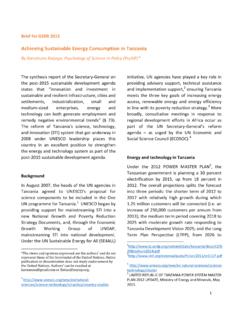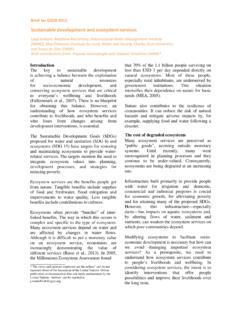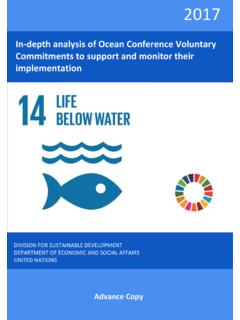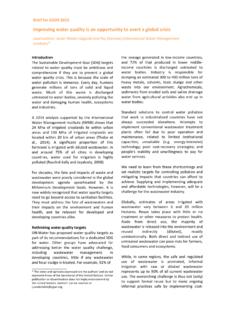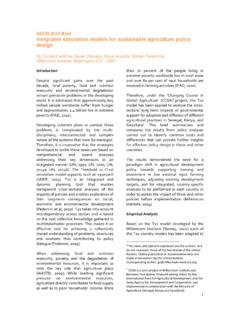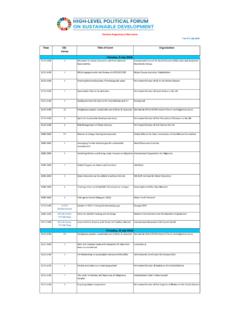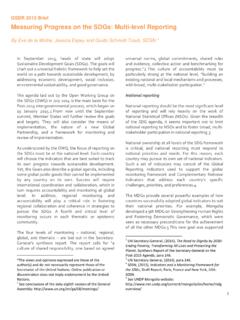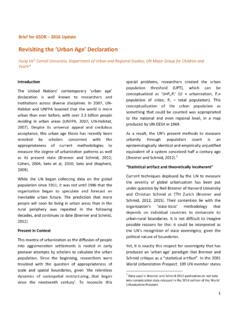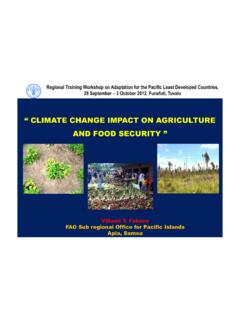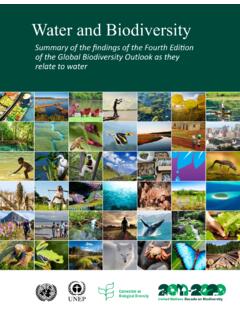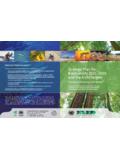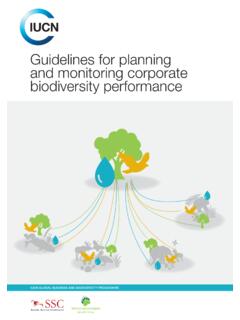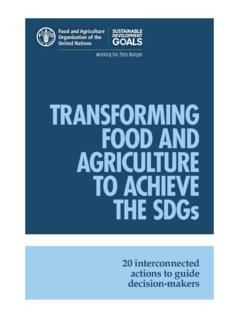Transcription of Issues Brief: Sustainable Agriculture
1 TST Issues Brief: Sustainable Agriculture1 I. Stocktaking While significant progress has been made towards achieving the MDGs, critical environmental, social, economic and institutional challenges are still to be overcome. Two crucial connected challenges are: i) the persistently high levels of hunger and malnutrition (870 million people in 2010 2012 [FAO, 2012a]) and particularly in the rural areas of many developing countries only slowly declining rates of poverty; and ii) an unsustainable and increasing burden of human activities on the earth s carrying capacity. Greenhouse gas emissions (GHG), biodiversity loss, nitrogen and phosphorus overuse and ocean acidification have reached alarming levels. These, coupled with the decreasing availability of fresh water and increased land degradation and deforestation, as well as inadequate policies to respond to these Issues , are undermining the livelihoods of ever growing numbers of people, especially those who live in extreme poverty.
2 These challenges are further exacerbated by the continuous growth of the world population. It has already surpassed the 7 billion mark and will grow to over 9 billion by the middle of this century. To meet the food demand of 9 billion people will require an increase in agricultural output of about 60 per cent (Alexandratos and Bruinsma, 2012) or a decline in food loss and waste. Increased food production will be a huge challenge, which will place ever greater pressures on all natural resources, including scarce agricultural land, forests, water and the climate. Indeed, a number of influential studies have suggested that Agriculture may not be able to produce the required food needed in order to sustain the growing world population with a healthy and active life ( Foresight, 2011; HLPE, 2011; FAO, 2012b). At the same time, Agriculture broadly understood including crop and livestock production, fisheries, and forestry provides income, jobs, food, and other goods and services, to the majority of people now living in poverty.
3 As a result, across countries overall GDP growth originating in Agriculture is, on average, at least twice as effective in reducing poverty as growth generated in non agricultural sectors, five times more effective than other sectors in resource poor low income countries (excluding sub Saharan Africa), and 11 times more effective than other sectors in sub Saharan Africa (FAO, 2012a). So going forward, Agriculture needs not only to provide adequate nutritious food, income, and decent jobs, but also address a host of environmental challenges. To respond to these multiple challenges, there is need to shift to more Sustainable forms of Agriculture and to introduce comprehensive policies that support this shift. The Green Revolution, based principally on a package of improved seeds, chemical inputs and irrigation, and supported by measures to strengthen agricultural policies and institutions, resulted in major increases in productivity and production of staple crops in a number of countries, especially in Asia.
4 Arguably, the intensification of food production under the Green Revolution also did much to preserve fragile, marginal, and forest lands that would otherwise have been cultivated for food crops more extensively (Stevenson et al, 2011). Real per capita incomes almost doubled in Asia between 1970 and 1995, and poverty declined from nearly three out of every five Asians in 1975 to less than one in three by 1995. Much of this decline is attributable to agricultural growth particularly in 1 The Technical Support Team (TST) is co chaired by the Department of Economic and Social Affairs and the United Nations Development Programme. The preparation of this Issues brief has been co led by FAO and IFAD, with contributions from UNWOMEN, WMO, UN ESCWA, WB, UNIDO, WTO Secretariat, UNOOSA, UNCCD/CBD, UNDP, UNESCO, OHCHR, UNFPA, ESCAP.
5 1smallholder farming systems, with accompanying declines in food prices and rising rural incomes. At the same time, it has been associated with high levels of energy use; and in many areas over use of agro chemicals and reliance on intensive mono cropping has resulted in environmental degradation, including unsustainable use of water and high levels of fertilizer run off, pesticide impacts, loss of agro biodiversity , soil contamination and land degradation. Thus agricultural intensification has been at the same time both a saviour and a threat, illustrating the importance of mainstreaming sustainability into a new intensification agenda. Overall, over the past half century, intensive Agriculture has increased global food production and enabled higher average per capita food consumption in many parts of the world even if in recent years rates of productivity growth have declined.
6 At the same time, in other parts of the world Agriculture has continued to perform below its potential due to low levels of use of external inputs. This is true in many parts of Africa in particular where, with some important exceptions, agricultural productivity has shown only little or no growth. Low rates of agricultural growth combined with high rates of population growth mean that many African countries have gone from being net food exporters to become net food importers. Agriculture is, by its very nature, a major user of natural resources, although in different ways and to different extents depending on farming system. Thus livestock is the world s largest user of land resources, using almost 80 per cent of all agricultural land; while globally, some 70 per cent of the water used is consumed by the Agriculture sector (Kabat, 2013).
7 Of greater concern is the fact that some agricultural systems are drivers of environmental degradation and loss of biodiversity (FAO, 2009; IAASTD, 2009, UNEP, 2010). Over 60 per cent of the world s major ecosystem goods and services are being degraded or used unsustainably (MEA, 2005), while the genetic diversity of crops, breeds, trees and aquatic resources on which Agriculture depends is at severe risk: this owing to global environmental change as well as the loss of knowledge associated with agricultural practices based on local varieties. Today, three crops only wheat, maize and rice supply more than half of humanity s calories. In addition, Agriculture and land use change (mostly bringing forest land under cultivation) is a major source of greenhouse gases, producing between a quarter and a third of all emissions; and more than any other sector, Agriculture is already adversely affected by unpredictable and extreme effects of climate change.
8 In the future, higher average temperatures are expected to reduce yield levels, particularly in the developing world; while increasingly unreliable weather conditions will likely undermine productivity growth everywhere. At the same time, roughly one third of food produced billion tonnes per year is lost or wasted globally (FAO, 2011b). Food is lost or wasted throughout the supply chain, from initial agricultural production down to final consumption. In medium and high income countries there are high levels of food waste at the consumption stage. In low income countries, by contrast, food is lost mostly on farm due to pests or lack of effective storage or in transportation and processing. While increasing food production is vital to meet the future increase in final demand, food availability can also be increased and the environmental costs of Agriculture production reduced by reducing the amounts of food lost and wasted.
9 The challenges facing Agriculture crop, livestock, fisheries and forestry over the coming decades are complex. To meet the growing demand for food, feed, fuel and fibre, agricultural systems need to become more productive and less wasteful. They need to provide decent incomes for farmers, including the landless and waged agricultural workers, and create employment in the rural areas that respects labour standards. They must be more efficient and more Sustainable , in terms of their use of, and effects on, the natural resource base. They need to be more resilient to shocks and changes, better able to withstand increased climatic shocks and rising temperatures. They have to reduce their levels of GHG emissions. They also have to provide other important ecosystem services, such as water provision, pollination, flood and disease control and maintenance of soil fertility.
10 They need to reduce their dependence on fossil fuels: Sustainable Agriculture necessarily relies on clean, green, renewable energy and increased energy efficiency. And finally, less produce must be wasted 2or lost post harvest. All of these challenges require that food and agricultural systems are made more Sustainable , not only from an economic perspective but also from environmental, social and institutional perspectives and at various scales, from the local to the global level. This requires a consistent focus on production systems that draw more effectively on production ecology principles to improve their productivity and efficiency while reducing their negative environmental and social impacts. Sustainable agricultural systems are likely to be associated with a more targeted use of external inputs, a more integrated approach to managing natural resources, and more analysis at the landscape/eco system level together with better management of ecosystem services.

